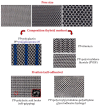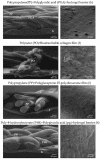Polymer Hernia Repair Materials: Adapting to Patient Needs and Surgical Techniques
- PMID: 34073902
- PMCID: PMC8197346
- DOI: 10.3390/ma14112790
Polymer Hernia Repair Materials: Adapting to Patient Needs and Surgical Techniques
Abstract
Biomaterials and their applications are perhaps among the most dynamic areas of research within the field of biomedicine. Any advance in this topic translates to an improved quality of life for recipient patients. One application of a biomaterial is the repair of an abdominal wall defect whether congenital or acquired. In the great majority of cases requiring surgery, the defect takes the form of a hernia. Over the past few years, biomaterials designed with this purpose in mind have been gradually evolving in parallel with new developments in the different surgical techniques. In consequence, the classic polymer prosthetic materials have been the starting point for structural modifications or new prototypes that have always strived to accommodate patients' needs. This evolving process has pursued both improvements in the wound repair process depending on the implant interface in the host and in the material's mechanical properties at the repair site. This last factor is important considering that this site-the abdominal wall-is a dynamic structure subjected to considerable mechanical demands. This review aims to provide a narrative overview of the different biomaterials that have been gradually introduced over the years, along with their modifications as new surgical techniques have unfolded.
Keywords: Polypropylene; meshes; polytetrafluoroethylene.
Conflict of interest statement
The authors declare no conflict of interest.
Figures








References
-
- Ratner B.D., Hoffman A.S. Biomaterials Science: An Introduction to Materials in Medicine. 3rd ed. Academic Press; San Diego, CA, USA: 2012.
-
- Luijendijk R.W., Hop W.C., van del Tol M.P., de Lange D.C., Braaksma M.M., Ijzermans J.N., Boelhouwer R.U., de Vriers B.C., Salu M.K., Wereldsma J.C., et al. A comparison of suture repair with mesh repair for incisional hernia. N. Engl. J. Med. 2000;343:392–398. doi: 10.1056/NEJM200008103430603. - DOI - PubMed
-
- Langer C., Liersch T., Kley C., Flosman M., Süss M., Siemer A. Twenty-five years of experience in incisional hernia surgery. A comparative retrospective study of 432 incisional hernia repairs. Der Chir. Z. Fur Alle Geb. Der Oper. Medizen. 2003;74:638–645. - PubMed
Publication types
LinkOut - more resources
Full Text Sources
Miscellaneous

